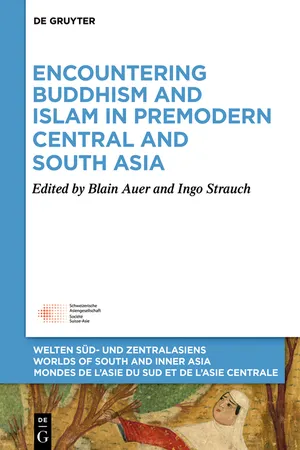
Encountering Buddhism and Islam in Premodern Central and South Asia
- 233 pages
- English
- ePUB (mobile friendly)
- Available on iOS & Android
Encountering Buddhism and Islam in Premodern Central and South Asia
About This Book
This volume brings together a variety of historians, epigraphists, philologists, art historians and archaeologists to address the understanding of the encounter between Buddhist and Muslim communities in South and Central Asia during the medieval period. The articles collected here provoke a fresh look at the relevant sources. The main areas touched by this new research can be divided into five broad categories: deconstructing scholarship on Buddhist/Muslim interactions, cultural and religious exchanges, perceptions of the other, transmission of knowledge, and trade and economics. The subjects covered are wide ranging and demonstrate the vast challenges involved in dealing with historical, social, cultural and economic frameworks that span Central and South Asia of the premodern world. We hope that the results show promise for future research produced on Buddhist and Muslim encounters. The intended audience is specialists in Asian Studies, Buddhist Studies and Islamic Studies.
Frequently asked questions
Information
- Abhishek Amar, Associate Professor at Hamilton College
- Blain Auer, Professor at Université de Lausanne
- Sara Cappelletti, Università di Pisa
- Bart Dessein, Professor at Ghent University
- Minoru Inaba, Faculty Member at Kyoto University
- Annette Schmiedchen, Professor at Humboldt-Universität zu Berlin
- Tamara Sears, Associate Professor at Rutgers University
- Walter Slaje, Professor at Martin-Luther-Universität Halle Wittenberg
- Ingo Strauch, Professor at Université de Lausanne
- Audrey Truschke, Assistant Professor at Rutgers University-Newark
Notes
Table of contents
- Title Page
- Copyright
- Contents
- Introduction: Situating the Encounter between Buddhist and Muslim Communities in South Asia
- The Power of the Islamic Sword in Narrating the Death of Indian Buddhism
- Reassessing the Muslim Attacks and the Decline of Buddhist Monasteries in the Thirteenth Century Magadha
- The Narratives on the Bāmiyān Buddhist Remains in the Islamic Period
- Ibn Baṭṭūṭa’s Buddhists: Monuments, Memory, and the Materiality of Travel
- Buddhism and Islam in Kashmir as Represented by Rājataraṅgiṇī Authors
- The Avatāra in Medieval South Asian Contexts: Dynamic Translation Across Hindu, Buddhist and Islamic Traditions in the Ghaznavid Period
- Buddhists, Hellenists, Muslims, and the Origin of Science
- Medieval Endowment Cultures in Western India: Buddhist and Muslim Encounters – Some Preliminary Observations
- List of Contributors
- Index